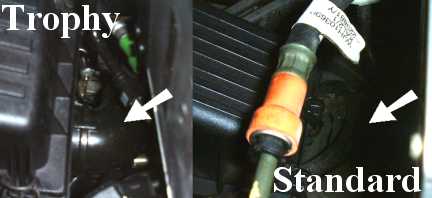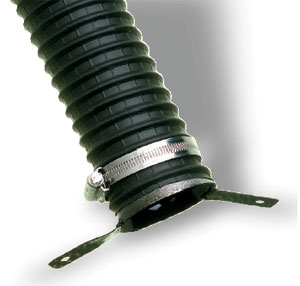 Alternative filter options
Alternative filter options
Elsewhere in these pages, we've discussed different air filters available for the MGF - be that a replacement panel filter for the standard air box, or a complete replacement induction system in the form of a cone filter. However, since these original tests were performed, things have moved on somewhat. Not only are different induction kits now available, but even the standard air intake system has been altered to a more efficient system design - the change point being around January 2001.
 These
air induction changes were first noted on the MGF 160 Trophy SE - and at that
time, much emphasis was placed on this modified air box as part of the
explanation as to why this version of the VVC engine had an additional 15bhp
over the standard car. As we can see from the picture, right, the MGF Trophy 160, post 2001 MGFs and the TF
(all variants) use a different design of air box to that used in the earlier models in
the MGF range. In these cars, the air intake system has an additional air intake into the air box as arrowed- which is absent on the standard
pre-2001 car. This 'elbow' can be seen when viewing from the boot through the
engine inspection grille (left side - and is located below the main fuel pipe,
which is more evident in the right of the picture).
These
air induction changes were first noted on the MGF 160 Trophy SE - and at that
time, much emphasis was placed on this modified air box as part of the
explanation as to why this version of the VVC engine had an additional 15bhp
over the standard car. As we can see from the picture, right, the MGF Trophy 160, post 2001 MGFs and the TF
(all variants) use a different design of air box to that used in the earlier models in
the MGF range. In these cars, the air intake system has an additional air intake into the air box as arrowed- which is absent on the standard
pre-2001 car. This 'elbow' can be seen when viewing from the boot through the
engine inspection grille (left side - and is located below the main fuel pipe,
which is more evident in the right of the picture).
This is shown in more detail below, where the lower halves of the standard air
boxes have been removed from their donor cars and photographed together. Both
boxes are orientated in the same way - as they'd be found in the car, and viewed
as though you were standing in the boot of the car and looking down.
Comparing air boxes
The air box to the left is the standard air box from an early MGF, whereas the air box to the right is from a MG TF. The differences between the two air box designs are quite striking.
The first is extremely obvious: the MG TF air box is significantly larger than that of the earlier MGF design. It is approximately twice the width, doubling the area of the panel filter that is used, and clearly doubling the volume of the air box itself. This will have benefits as this increases the volume of air that can pass through the filter and into the engine - effectively this is a much freer flowing design.
The second obvious difference is that aforementioned additional air intake at the rear of the air box - in this picture, it is the elbow to the bottom of the MG TF air box pictured to the right of the image. Interestingly, this intake tube continues towards the centre of the air filter, perhaps indicating the area of greatest flow in the air box?
The
design of the late pattern air box is shown with the filter in situ in the two
images, left.
In the first image, the photographer is standing at the rear of the car, looking backwards into the engine bay, peering in through the inspection grille that has been conveniently removed for this shot. Notice the rubber elbow joint that takes the air from a hose that doubles back on itself, such that the intake is immediately below the air box itself. One very easy performance modification is to undo the cable ties that retain this air intake in this position and relocate it towards the left hand side engine air intake grille. This modification should help drop intake temperatures and boost power, irrespective of the type of panel air filter employed.
The
second image (left) is where the engine bay inspection cover has been removed.
The photographer is looking backwards along the car, and into the engine bay.
Here we can see the additional air intake tube into the centre of the air box.
This particular intake draws air from the same place as the standard original
induction system - namely, from the centre of the rear cross member of the rear
subframe.
Again, as with the air intake described above, this too can be relocated, although a longer flexible hose is probably required (70mm ID). Again, if this intake hose can be located in the left hand side engine intake grille, then so much the better for intake temperatures.
If these simple modifications are combined with a decent high flow panel filter (e.g. K&N, Pipercross, Green etc) then a decent improvement in performance can be expected (perhaps in excess of the 2-5 bhp found in our earlier filter test). Unfortunately, I've not been able to afford the rolling road time as yet to look at this particular modification, but if you've done it, please let me know!
In a similar vein, is it worth fitting a late pattern air box into an early MGF?
This isn't something I have tried, however, it should be possible, and moreover,
if the air intakes are well positioned to make most of cool, clean air, it
should prove to be quite beneficial when used in conjunction with a decent panel
air filter. Why do I have reason for thinking this? Simple - read on below:
Intake modification using the standard early pattern air box
 In a similar fashion to what I've described above for the 'Mk2' intake system, others have already been using standard
early air boxes,
but with more direct air feeds to the left hand side engine air intake. In fact,
this is such a well-trodden route, that you can even buy a cold air induction
kit straight out of the box from Moss Europe (part number MGF139, cost about £50
at the time of writing).
In a similar fashion to what I've described above for the 'Mk2' intake system, others have already been using standard
early air boxes,
but with more direct air feeds to the left hand side engine air intake. In fact,
this is such a well-trodden route, that you can even buy a cold air induction
kit straight out of the box from Moss Europe (part number MGF139, cost about £50
at the time of writing).
By performing this set up, intake temperatures can fall by as much as 12 Celsius, which will have certain performance advantages. In fact, for the reasons stated elsewhere, this particular bit of intake re-plumbing will have an even greater benefit for the early MGF, as it does away with significant amounts of intake restriction, by removing several 90 degree turns, a resonance box etc etc.
So it is with no surprise that this set up, in conjunction with a K&N panel filter can reap considerable benefits. Roger Parker has independently shown on the rolling road that this sealed air intake system runs some 10 degrees Celsius cooler than an equivalent standard system. Best still, definite power gains can be seen with this re-routing of the intake. The power curves below were kindly supplied by Bruno from Portugal. By using a K&N air filter, removing the lower elbow to the resonance box, and using some ducting to enable air from the left hand side air box, an additional 10+ bhp was found on this VVC installation. (Apologies for the quality of the images here)
| Before the
air intake modification. The figure opposite shows a scan of the power curve Bruno obtained for his car using an unmodified air intake system (but, using the K&N panel air filter). Peak power was approximately 100 kW (134bhp), which appears to occur at around 6250rpm and then plateaus - which tallies well with the data we collected from our panel filter tests found else where on these pages. However, the 134bhp figure seems somewhat low, but for arguments sake, let us take these figures at face value - and assume that no foul play is at hand in terms of 'operator bias'. (Red line = torque, cyan line = power @ wheels, magenta line = estimated power @ fly wheel) |
|
| After the air intake modification. In this figure, Bruno has re-routed the air intake as described above to the left hand side air intake. A K&N panel air filter is also used as before. Now peak power is up to around 109 kW (148 bhp) - a very useful and significant power increase of 14bhp. Peak torque too increases, from the previously recorded 160 Nm (118 lb.ft) to 165+ Nm (124 lb.ft) @ 4500rpm. All very impressive stuff. Even assuming that there is a 'problem' with the base line power figure, there is still a useful gain in power, as VVCs typically record somewhere in the region of 143 bhp, so this is still showing genuine gain of at least 5 bhp, and possibly more. |
|
If you can DIY, then this route is definitely the cheapest way to improve the performance of your MGF - and indeed of your TF.
You can read about my DIY air box for the K&N 57i cone filter here.
The Next Generation of Induction kits
What I haven't
discussed here are alternative induction systems that have recently entered the
market, including the ITG Maxogen, the Pipercross Taipan and so forth.
These kits are the new generation of induction kits that completely do away with the standard air box, in favour of a cone filter insulated from the heat of the engine bay inside a specially designed enclosure. Pictured opposite is the Taipan - one of the 'next generation' filters - mounted in a somewhat unorthodox manner (convenience for rolling road testing expedited this particular solution!)
The question, as always, is 'are they any good'. Unfortunately, from my perspective, the jury is certainly out on that one, as the King Cone 2 test held at Emerald were extremely disappointing - perhaps hampered by high ambient temperatures. However, I know that Roger Parker has since seen some very encouraging results with the combination of ITG and 52mm throttle body (showing +15bhp on a VVC). Are they worth over 300 quid for 8 - 15 bhp though? Well, possibly - but when compared to DIY efforts it does show these commercial offerings in a harsh light. But then, you are not paying for your own time are you? Or R&D? Considering a stainless steel exhaust is similar money, and has perhaps less performance potential, well, I am inclined to give these filters the benefit of the doubt.
When we finally arrange King Cone 3, you know where the results will be published don't you?